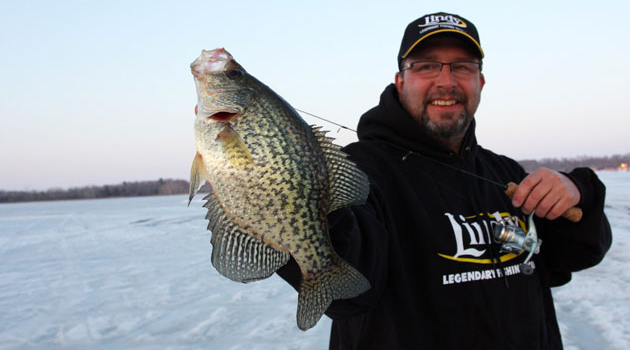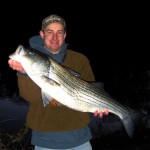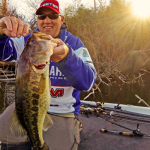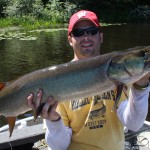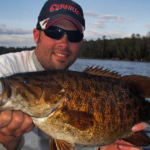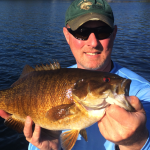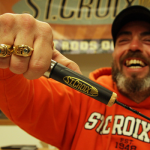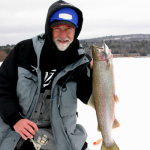By Daniel Quade
Visions of icing slab crappies seldom include crowds of anglers. More often, sweet dreams of icy nirvana center on remote backcountry waters or hidden gems that somehow fly under the masses’ radar. However, while untapped fisheries can be dynamite, you can also enjoy banner catches on waters besieged by the bucket brigade.
Panfish fanatic Paul Fournier knows the drill. Years of practicing his craft on hard-hit lakes sprinkled across central Minnesota’s Minneapolis-St. Paul megatropolis have left him well versed on tackling pressure-cooker crappies. His finely tuned tactics include a blend of pre-trip recon and refined fishing strategies to ice slabs that elude other anglers.
“Start by doing your homework, so you know as much as possible about a lake before you get there,” he said.
Prior to an outing, Fournier scours lake maps for trends in depths and structural subtleties, often breaking lakes into one of two categories based on whether it has a deep or shallow basin.
In systems characterized by deep water, crappies often frequent the same locations in early winter as they did in late fall, such as the outside edge of deep weedlines that are adjacent to deep water. The depth of the edge varies by lake, but 10 to 15 feet is a common range on many waters. Often, crappies slide out deeper to gather over nearby soft-bottom basins as winter progresses.
Finding fish in shallow-basin lakes is often a matter of ferreting out the deepest water available.
“Depth is relative, but for example, a 20-foot hole in a lake with lots of 12- to 16-foot water can be a hot zone,” he says.
In total bathtubs, factors such as well-oxygenated inflows, bottom content changes and subtle differences in weed growth or woody cover can channel fish activity.
Such physical distinctions help guide Fournier’s on-ice search efforts, but he also brushes up on the fishery’s forage base. Finding out whether the crappies are feasting on insects or eating other fish, including minnows, young-of-the-year perch or even juvenile panfish, also steers him toward potential drop zones. For example, an abundance of food in shallow, still-green vegetation can hold slabs in surprisingly skinny water, offering savvy anglers a shot at unpressured panfish, even while offshore schools suffer wholesale slaughter in mob scenes barely a long cast away.
Once Fournier settles on a likely fishing area, he focuses on primary strike zones comprised of the best structure or cover the spot has to offer.
“Examples include the tip of a point extending into deeper water, and an inside turn on a drop-off or weedline,” he said.
Rather than punching a hole or two and hunkering down over such a sweet spot, he drills out a 20-hole grid pattern that starts shallow, covers the edge of the break or transition line, and stretches into deep water. Drilling completed, he quietly walks from hole to hole, using sonar to check for fish.
“Multi-crappie ‘Christmas trees’ are ideal,” he grins. “They signal active fish competing for food, a scenario that encourages large crappies to feed.”
He cautions, however, that even though the biggest fish may be the first to slide in for a look at your lure, they can be the toughest to trigger. Fournier favors a lengthy jigging rod, say, 36 inches or longer, to keep his silhouette out of the hole. He spools with 4-lb monofilament mainline, ties on a small ant swivel to limit line twist, and then adds a 2- to 4-foot leader of 2-lb fluorocarbon. He notes that even though water clarity dictates leader length, it should always be long enough to prevent sunfish from swarming the swivel.
Presentational options abound, given the near-endless variety of jigs, jigging spoons and other hardbaits at his disposal. Still, Fournier often throws a reliable one-two punch. His first strike is typically a small horizontal-hanging jig like the Lindy Tungsten Toad.
“Since it fishes heavy for its size, it works equally well for targeting deep water off the edge of the break, and for punching through shallow weeds,” he says. “Waxies and eurolarvae are common tippings, mostly skin-hooked wacky style, though super-wary slabs may demand the bait be threaded on lengthwise. Plastic baits can be deadly on slab crappies, too, provided you learn how to fish them. Fill up the tub or a sink and practice your moves at home.”
His second rod brings slightly heavier metal to the table, in the form of a small Lindy Rattln’ Flyer or Frostee Spoon, with waxies strung between the treble tines. Rigged this way, they’re hard for fish to pick off the hooks, he says.
When fishing either the Toad or a spoon, Fournier’s mindset and jig strokes are similar.
“Fish above the crappies, slowly coaxing them higher,” he says. “Subtly work the rodtip back-and-forth so the lure moves from side to side.”
When a rising crappie stalls out, Fournier drops the jig back down to where he jigged it last. Often, this triggers a follower to dash down and strike.
Two to three jig and spoon sequences are typically sufficient to milk a hole of its biters. Before leaving, however, Fournier taps the Toad for a final descent.
“Let it fall just above the fish, give it a jiggle, pause it about 20 seconds and jig it again,” he says. “If that doesn’t work, move on.”
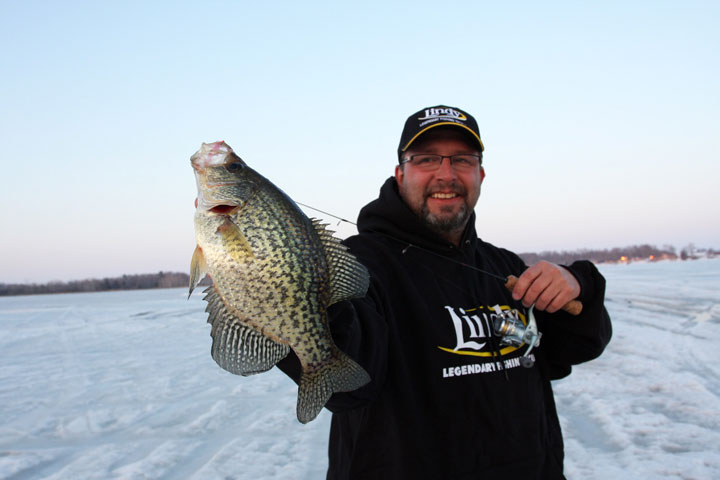
To be fair, this is just the tip of Fournier’s presentational iceberg. He also works swimming hardbaits like the Lindy Darter into the act, especially on deep lakes, as well as in shallow basins offering a decent drop-off. Dropper rigs, too, have their moments. One of his favorites is a Lindy Ice Jig or Toad dangled 6 to 8 inches beneath a spoon. In shallow water, a slow-falling soft plastic bait gets the nod. He especially likes a Lindy Watsit Grub, skin-hooked on a horizontal jig.
Time of day can also be an ally.
“Crappies tend to school up and become more active at night,” he says. “Sunrise and sunset are also peak activity periods for big crappies.”
In the end, he believes the key to making your crappie dreams come true on pressured waters is fishing smarter and working harder than the crowd. Do that and your well on your way to your best season ever.


